This 1976 BMW 2002 was converted to electric. How Nomad Motors did it

I moved to Midcoast Maine in 2010, and since that time, there are plenty of local sights I’ve become accustomed to. Roadside blueberry stands in the summer, endless lobster boats and angry drivers from Connecticut are all part of life here, and nobody bats an eye. In terms of the automotive world, there’s not much to see here, but I recently stumbled across a little shop of wonders hidden up the coast a bit from my home. Nomad Motors, run by Keith Martin, converts classic vehicles using electric drivetrain components, making them modern, usable and reliable in the process.
Martin invited me to his shop a few weeks back to give me a tour and show off his creations, including a fully converted 1976 BMW 2002. Though Nomad has a stunning Land Rover Defender in progress, we focused on the BMW and Martin’s path to starting a business around his passion. He said that he and his wife currently own four classic cars and wanted to spend more time driving them than fixing them. He was able to lean on industry veterans EV West and Electric GT to help get started, and Nomad was born.
Martin already owned the BMW when the itch to electrify hit. While a typical Nomad conversion takes around three months, depending on the specs, Martin’s 2002 took closer to a year because of the full-body restoration he did before installing the electric drivetrain.
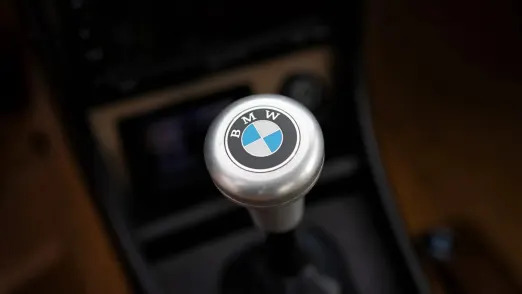
In place of the car’s stock 2.0-liter engine, Martin installed a Netgain Hyper 9HV motor making 121 horsepower and 162 pound-feet of torque — a substantial improvement over the car’s factory powertrain, which made 98 horsepower and 106 pounds of torque. The conversion netted a 2-second improvement to the car’s 0-60-mph time, with it now taking just 8.5 seconds to reach the mark.
Impressively, the 2002 retained its four-speed manual transmission. Yes, you read that right. A real four-speed in an EV. Where most new EVs feature single-speed transmissions that transfer electric motor power directly to the wheels, the four-speed is a novelty. It also gives the 2002 two more gears than the Porsche Taycan, one of the quickest EVs around.
Martin mounted the electric motor to the car’s original four-speed gearbox using an aluminum adapter plate. He noted that the manual provides a more engaging driving experience and creates a pleasing gear noise in place of the buzzy engine sounds the 2002 came with. The car does not need the clutch in stop-and-go traffic because the electric motor can’t stall. Looking at the rig inside, there’s no indication of what’s going on underneath other than a small digital battery display next to the shifter.
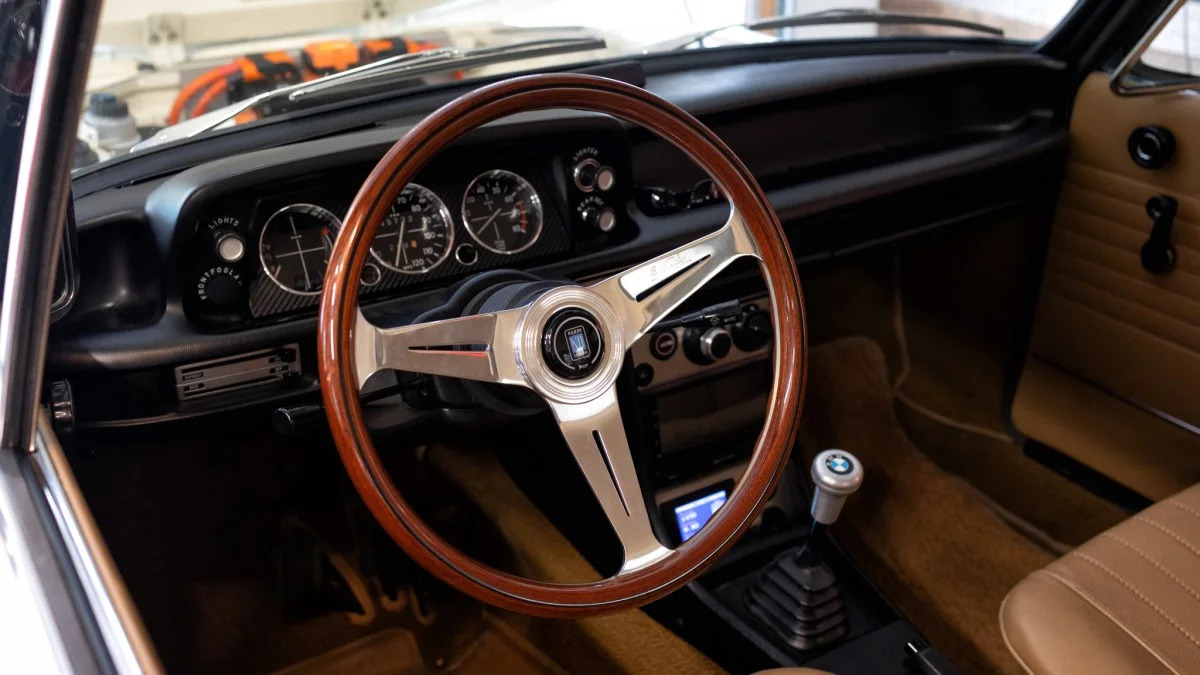
Power for the motor comes from six liquid-cooled Tesla 18650 batteries wired in series. It has a total pack voltage of 144 volts and a 32-kWh capacity. Power flows from the batteries through a sealed HV junction box. Martin noted that the box contains all of the switches, fuses and service disconnects to keep everything safe. He also installed a battery management system that monitors voltage, temperatures, amperage and the state of charge. If the system detects an issue, it will shut down the vehicle to prevent damage.
Removing a gas engine also removes several components needed to run it, including the alternator, coolant and manifold vacuum. Because of that, the car needs a DC-DC voltage converter to power low-voltage systems, and the car relies on a small vacuum pump for brake pressure. There’s also an electric heating element to heat the cabin and defrost the windows.
The 2002 is known for being a light, balanced car, so there were many ways to go wrong when jamming a heavy electric drivetrain into it. Martin installed a cross-member on the subframe to support the motor’s added torque, and he lowered the front end by 1.5 inches using shorter coil springs. He said the conversion cut about 150 pounds from the front end.
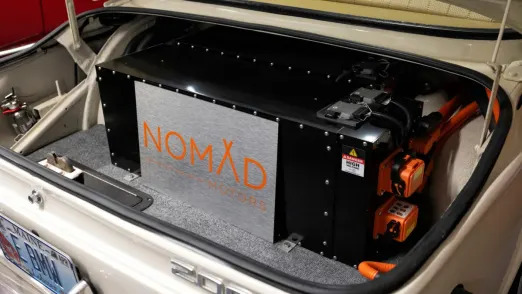
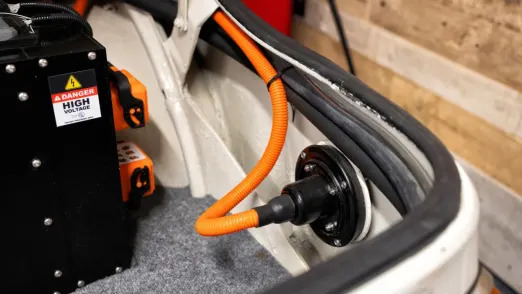
Martin positioned the battery pack in the trunk, adding 350 pounds behind the rear seats. Considering weight was removed up front, it would be interesting to see what the handling balance would be like as a result. Nevertheless, the 2002 came from the factory with heavy-duty springs, leaving Martin to install upsized anti-sway bars and wider tires. The car’s stance is gorgeous, and there’s no hint of the level of work and modifications done watching it drive down the road.
If you’re wondering how much something like a BMW 2002 EV would cost, it’s probably not as much as expected. Martin said the components to perform the conversion could range from $20,000 to $40,000, with the complete car coming in between $40,000 and $60,000, depending on the customer’s desired range, power and options. That could be a great way to revive a non-running 2002 if it’s solid enough underneath.
Though we spent less time talking about Nomad’s in-progress Land Rover Defender, Martin shared interesting details on the SUV’s design. The nearly customer-ready vehicle has a Tesla Model 3 rear drive unit that he said will improve the original vehicle’s dynamics in every way.
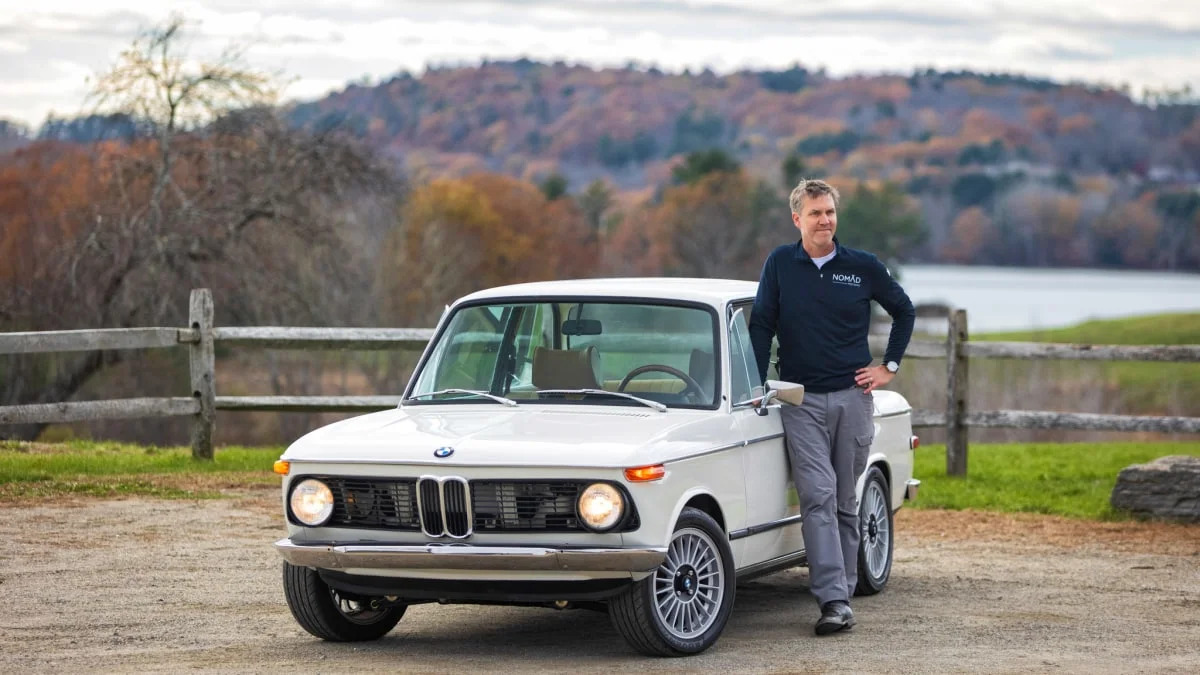
Keith Martin and his 2002
I’m fully aware that there is a large and vocal group of enthusiasts who feel converting classic gas cars to electrics is blasphemous. Still, I think those making such grandiose statements gloss over some nuance. There is a substantial argument to be made that the feel, smell and sound of internal combustion engines are what make them unique and give old cars their appeal, but on the flip side, there are plenty of classic car owners who just want to drive and enjoy their vehicles without having to wrench on them every few weeks.
It’s also worth diving into the attitude with which Nomad approaches its conversions. The appeal of many vehicles like the old-school Land Rover Defender is in their look, and here in New England, they’re popular as summer coastal runabouts, where the clogged roads don’t allow much hot-rodding. While the conversions I saw undoubtedly improved the performance over old gas engines, they didn’t make me feel like a crime had been committed. Martin looked at how he and his wife drove the BMW before swapping the engine and their desire to enjoy the car with some degree of reliability. The customer’s Land Rover will be used for putzing around the harbor for a few months each year, making it the perfect candidate for a conversion. In other words, he’s not ripping out a heritage powertrain and replacing it with something that doesn’t fit the original vehicle’s charm.
Nomad is still somewhat in its early days and is operating out of a small space on the coast, but Martin has acquired land to build a home base for the company to build, service and store customer vehicles. The company offers conversions for several vehicle types, including the Porsche 356 and 912, BMW 2002, VW Beetle and Bus, and pre-1980 Land Rover Defenders.
While Martin’s company and work are still in their early stages, the conversions will likely become more popular as time goes on and parts for classic cars become rarer and more expensive. The work takes time and money, but once complete, owning and driving the cars becomes a lot easier. That’s not exactly the future many enthusiasts want, but it could be one of the best ways to keep old vehicles on the road, where they belong.





